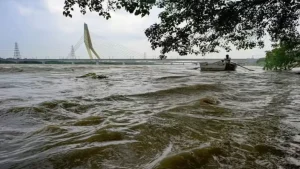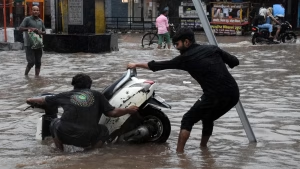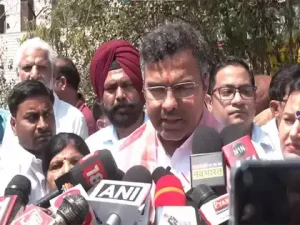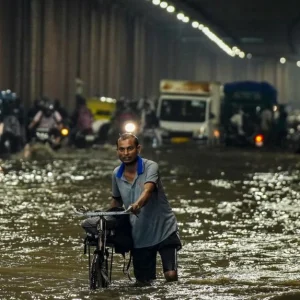New Delhi – The India Meteorological Department has placed Delhi NCR On Red Alert status for September 2, issuing orange warnings across the National Capital Region as heavy rainfall continues to batter the area. The escalated weather alert system reflects growing concerns about potential flooding and infrastructure disruption throughout Delhi, Gurugram, and Noida.
Delhi NCR On Red Alert conditions have already triggered significant disruptions including traffic jams, flight delays, and metro service interruptions throughout Monday. The comprehensive nature of these disruptions demonstrates the severity of current meteorological conditions affecting the entire region.
Emergency management authorities have activated comprehensive response protocols as Delhi NCR On Red Alert status necessitates coordinated efforts across multiple jurisdictions to protect residents and maintain essential services during the weather crisis.
Yamuna River Flood Threat Escalates Dramatically

The most critical concern facing Delhi NCR On Red Alert authorities involves potential Yamuna river flooding by Tuesday following heavy inflow from Haryana’s Hathnikund barrage. Upstream rainfall in Himalayan regions has significantly increased water discharge, creating downstream flood risks.
Water released from the Hathnikund barrage typically requires approximately 48 hours to reach Delhi, meaning Delhi NCR On Red Alert flood preparations must account for Tuesday mid-day peak water levels. This timeline provides limited preparation window for evacuation and emergency response coordination.
Current Yamuna water levels at Old Railway Bridge measured 204.94 meters at 5 PM Monday, approaching the 205.33-meter danger mark. When Delhi NCR On Red Alert flood conditions reach 206 meters, mandatory evacuation procedures begin for floodplain and low-lying area residents.
Infrastructure Response and Traffic Management

The Delhi Disaster Management Authority has ordered closure of Old Railway Bridge traffic over Yamuna river from 5 PM Tuesday, September 2. This preemptive measure reflects Delhi NCR On Red Alert protocol prioritizing public safety over transportation convenience during flood conditions.
Bridge closure represents significant infrastructure response to Delhi NCR On Red Alert flood warnings, potentially affecting thousands of daily commuters who rely on this crossing. Alternative transportation arrangements become crucial for maintaining regional connectivity during emergency conditions.
Traffic management challenges associated with Delhi NCR On Red Alert status extend beyond bridge closures to encompass waterlogged roads, disrupted metro services, and flight operation interruptions affecting regional mobility networks.
Government Assurance and Emergency Coordination


Delhi Minister Parvesh Sahib Singh Verma addressed public concerns regarding Delhi NCR On Red Alert conditions through social media, emphasizing government preparedness and urging residents to avoid panic. Official communications stress comprehensive emergency response capabilities and ground-level team deployment.
The ministerial statement regarding Delhi NCR On Red Alert emergency management emphasizes Delhi government’s high alert status and commitment to protecting every resident. This communication strategy aims to balance transparency about risks with reassurance about preparedness measures.
Government coordination during Delhi NCR On Red Alert conditions involves multiple agencies working together to monitor conditions, coordinate evacuations, and maintain essential services throughout the weather emergency.
Educational and Workplace Closures in Gurugram
Gurugram administration has ordered comprehensive closures of schools and offices for Tuesday due to Delhi NCR On Red Alert weather conditions and IMD orange alert warnings. This decision prioritizes public safety by minimizing unnecessary travel during dangerous weather conditions.
Work-from-home arrangements and online classes represent practical responses to Delhi NCR On Red Alert conditions, allowing educational and economic activities to continue while protecting residents from travel risks. These measures demonstrate adaptive approaches to severe weather management.
While Delhi and Noida have not issued similar comprehensive closure orders, some private offices have independently implemented work-from-home policies in response to Delhi NCR On Red Alert conditions, showing varied institutional responses to weather warnings.
Noida Flood Preparations and Animal Welfare
Noida officials have implemented comprehensive flood preparation measures as Delhi NCR On Red Alert conditions threaten the region. ACEO Sanjay Kumar Khatri compared current water release levels to 2023 flood conditions, indicating similar severity expectations.
Proactive animal welfare measures include relocating 800 cattle from a 135-hectare gaushala to safer green belt areas. These Delhi NCR On Red Alert response measures demonstrate comprehensive emergency planning extending beyond human safety to include livestock protection.
Evacuation announcements have been broadcast in flood-prone areas while deployment of monitoring staff ensures continuous safety oversight during Delhi NCR On Red Alert conditions. These systematic approaches reflect lessons learned from previous flood events.
Regional Impact Beyond Delhi NCR


The weather system creating Delhi NCR On Red Alert conditions extends northward into Punjab and Himachal Pradesh, where additional heavy rainfall is forecast. This broader regional pattern indicates sustained meteorological challenges affecting multiple states.
Punjab has already experienced significant casualties with 29 deaths reported across flooded districts, demonstrating the deadly potential of current weather patterns affecting Delhi NCR On Red Alert regions. Over 1,000 villages across 10 Punjab districts remain flooded from previous rainfall.
Chandigarh officials have conducted field assessments of Sukhna Lake and drainage systems, showing regional coordination in responding to weather conditions that have placed Delhi NCR On Red Alert. These preparations reflect comprehensive regional emergency management approaches.
Public Safety and Evacuation Protocols
Delhi NCR On Red Alert protocols include systematic evacuation procedures triggered when Yamuna water levels reach critical thresholds. Current monitoring systems provide early warning capabilities essential for protecting vulnerable populations in flood-prone areas.
Emergency response teams have been strategically positioned throughout Delhi NCR On Red Alert zones to facilitate rapid evacuation and rescue operations if conditions deteriorate further. These deployments reflect proactive emergency management rather than reactive response strategies.
Community preparedness during Delhi NCR On Red Alert conditions relies on clear communication, accessible evacuation routes, and coordinated response between multiple government agencies and emergency services.
Conclusion: Comprehensive Emergency Management Response
The implementation of Delhi On Red Alert status demonstrates sophisticated emergency management capabilities designed to protect millions of regional residents from severe weather threats. Coordinated responses across multiple jurisdictions show effective inter-governmental cooperation during crisis conditions.
As Delhi On Red Alert conditions continue developing, the effectiveness of current preparation measures will be tested by actual flood conditions expected Tuesday. The comprehensive nature of current preparations suggests regional authorities have learned valuable lessons from previous weather emergencies and applied them systematically to current challenges.

